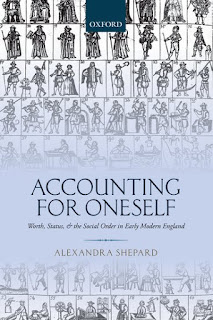 including Meanings of Manhood in Early Modern England (2003), and she is currently leading an International Network, funded by the Leverhulme Trust, on gender and work in early modern Europe.
including Meanings of Manhood in Early Modern England (2003), and she is currently leading an International Network, funded by the Leverhulme Trust, on gender and work in early modern Europe.Shepard applied the “Page 99 Test” to her latest book, Accounting for Oneself: Worth, Status, & the Social Order in Early Modern England, and reported the following:
Page 99 falls roughly in the middle of the first of the book’s three sections—on ‘Wealth and Poverty’—and contextualises the value of 40 shillings (£2) established through a series of equivalents:Learn more about Accounting for Oneself at the Oxford University Press website.In real as well as symbolic terms 40s. was not an insignificant sum. Forty shillings was a not untypical annual wage for a domestic servant in the later sixteenth and early seventeenth centuries. Forty shillings comprised one-fifth of the amount required to rebuild a simple peasant or suburban dwelling after the mid-seventeenth century destruction of civil war. A variety of items amounting to the value of 40s. were regularly grouped together as lots in probate inventories, presumably to make the accounting process easier, but also suggesting that this provided a routine means of quantification through keeping the unit of value constant rather like the changing size (rather than price) of a penny loaf. Forty shillings was the fourth most frequent value assigned to goods itemized in a sample of inventories from Kent between 1600 and 1650, after 10s., 20s., and £5. In a selection of inventories from Thame (Oxfordshire) dating from between 1598 and 1699, 40s. was the second most frequent value (after 10s.), whereas 41s. occurred only once in the entire dataset. As is evidence from the Thame sample, in the later sixteenth and early seventeenth centuries 40s. was the value frequently assigned to bedsteads and associated bedding—components of a household’s good requiring relatively high outlay. In a shoemaker’s inventory from 1604, for example, one truckle bed, one featherbed, one flock bed, two joined bedsteads, one straw bed, and a collection of bolsters, blankets, and ‘old coveringes’ were grouped as one item valued at 40s. Forty shillings also amounted to quite large quantities of furniture. In 1618, a table and frame, eight joined stools, eight cushions, two chairs, one cupboard, and two iron dogs formed one item in a yeoman’s inventory from select contents of his hall, valued collectively at 40s. In 1637, just four pairs of blankets and two coverlets that had been in a husbandman’s possession were appraised at 40s., comparable to the value of his “wearing clothes”, but 40s. worth of goods could still comprise a significant asset to a household in the later seventeenth-century, such as the range of brewing equipment itemized in the inventory of a blacksmith in 1682, which included at least thirteen barrels, vats, and tubs.This extract forms part of a larger discussion of the complex culture of appraisal in the early modern period, and the ways in which certain values (in this case 40 shillings) held wider social and political associations beyond merely signifying quantity. Besides functioning as a very common unit of account, the possession of moveable property worth 40s. was the threshold for political participation of various kinds and it also functioned as a critical benchmark in processes of social estimation, increasingly used to demarcate a dividing line between those with at least a modicum of credit and self-sufficiency and those identified as poor and worryingly dependent on account of having nothing more than their labour on which to live.
The book is based on a sample of over 13,500 statements provided by witnesses in court between 1550 and 1728 in response to questions designed to establish their creditworthiness. It is designed as a ‘bottom up’ or grassroots account of the social order and social change—fully inclusive of the voices of women as well as men—on the basis of the language of self-description that witnesses deployed when asserting their credibility. Disappointingly, p. 99 does not include any direct reference to the myriad shards of self-positioning on which the overall analysis is centred. The book charts the dramatic widening of wealth inequality between the mid-sixteenth and mid-seventeenth centuries and its consequences for the ways that people assessed their own and each other’s social position. A central argument is that the chasm that opened up between rich and poor involved not only the redistribution of wealth but also its redefinition. In addition, a shift of emphasis towards what people did for a living as opposed to what they had to live on (which became increasingly private), was part of the realignment of the calculus of esteem from the later seventeenth-century.
The book attempts to combine painstaking recovery of the details of the material lives and social perceptions of a broad social range of men and women with sustained engagement with larger debates about the character of economic and social change, and the place of class, credit and consumption in the development of modernity. Whether ‘the quality of the whole’ is revealed in this extract depends on an evaluation of the rest of it, but I’ll leave that to the reviewers!
--Marshal Zeringue



